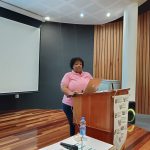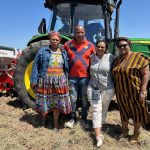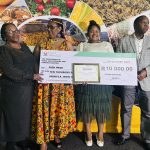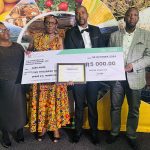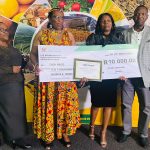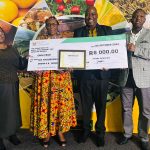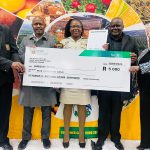
by Olwetu Batyi | Nov 21, 2024 | Uncategorized

Maralese Nonkonana’s eyes lit up as she received two brand-new industrial sewing machines from
the Department of Rural Development and Agrarian Reform (DRDAR) on behalf of her
cooperative Masiphathisane Clothing at a handover ceremony held in Graaff-Reinet, Beyers Naude
Local Municipality yesterday (SUBS: WEDNESDAY 20 NOVEMBER).
This initiative is part of DRDAR’s continued efforts to foster the growth of small business textile
enterprises enabling them to produce high-quality garments and generate sustainable income. By
providing the necessary tools and support, the DRDAR aims to stimulate job creation and
economic development within the province.
Hailing from the small town of Steytlerville in Beyers Naude Municipality with a population of less
than 5000, Nonkonana’s fortunes and six other members of the cooperative will change for the
better thanks to DRDAR’s generous donation.
“I’m thrilled to receive these sewing machines. They will enable us to take our business to the
next level, create jobs, and contribute to the growth of the local economy.
“Currently we only have one sewing machine in the cooperative and we use that to supply local
clients including the local primary school. With these new machines, we will be able to produce
more clothing items and hopefully we are going to get more clients now including government
departments,” added Nonkonana.
She said to them, the sewing machines are more than just equipment – they’re a key to unlocking
her cooperative’s full potential.
Nokholekile Hermans hailed the Department for the donation saying the seven families
represented by each member of the cooperative will change for the better.
“We will now be able to send our children to school. These will assist us to feed our families as
we will now generate more income,” Hermans said.
Since 2017, the department has supported 976 clothing and textile cooperatives/businesses,
benefiting 4,234 individuals. More than R25m has been invested in providing industrial machines
and materials to primarily women, youth, and people with disabilities.
In the current financial year, the Department has allocated more than R2,2m for the procurement
of sewing machines to support 103 cooperatives across all six districts and two metros in the
province.
Speaking at the handover, DRDAR MEC Nonceba Nkontsiwe said the department wanted the
beneficiaries to improve the quality of their work and become commercial business people.
“I want to encourage you to move forward and become sustainable because you cannot always
depend on government. One day you should open your own shops or supply commercial clothing
retail stores” Kontsiwe said.
She added that government wanted to empower women and liberate them from becoming
dependent to men. She expressed joy that that most beneficiaries were women, saying this will
assist them to grow their enterprises

by Olwetu Batyi | Oct 22, 2024 | Uncategorized

Department Enhances Records Management with Information Sharing Session
The Head Office Records Management Unit recently hosted a comprehensive information sharing session for employees, including district representatives. The objective was to educate staff on procedures for archiving and disposing of documents.
Key Presentation topics included:
1. Human Resource Registry roles within the department
2. Messenger duties and responsibilities
3. Records management legislation
4. Essential procedures for document disposal and archiving

The session clarified document management processes, emphasized adherence to regulatory requirements and encouraged employee participation in maintaining accurate records
The session occurred in the backdrop of a special commendation for its compliance efforts, ranking among the top in the province. However, there is room for improvement to achieve 100% compliance and optimal status.
To ensure uniform records management practices, similar sessions are scheduled for district employees. This proactive approach will standardize procedures across locations, enhance employee knowledge and involvement
and foster a culture of effective records management

by Olwetu Batyi | Oct 21, 2024 | Uncategorized

In a significant move to combat poverty and malnutrition, promote sustainable agricultural
development and food security, the Eastern Cape Department of Rural Development and
Agrarian Reform (DRDAR) launched an R80 million cropping programme today (SUBS:
Wednesday 16 Oct).
Located in Mbhashe Local Municipality, an area that once had high poverty levels in the
province, Ngxakaxha village served as a meaningful backdrop for the launch, coinciding with
World Food Day.
This year’s theme, “Right to Food for a Better Life and a Better Future,” underscores the
fundamental human right to access adequate food.
Mawande Jama, a beneficiary of the programme who is part of a project that is producing
sorghum attested to its transformative impact.
“This project has assisted us greatly. We planted sorghum, and the support created job
opportunities from soil preparation to harvesting and even employed rangers,” Jama said.
Social Development Minister Sisisi Tolashe lauded the programme as a crucial step in
implementing government strategies to fight food insecurity and malnutrition. “Empowering
people with skills to produce their own food reduces dependence on social grants,” Tolashe
emphasized.
She added: “… We should replicate the lessons learnt from this programme and implement it
nationally. It is through programmes like these that government can be able to fight
malnutrition and food insecurity as reported by Stats SA. We want people to be empowered
with skills to produce their own food instead of being dependent on social grants hence we
applaud the department for these initiatives. As government we need to ensure we turn things
around and ensure food is produced hence we are here today”.
Nozibele Nyalambisa, Member of the Portfolio Committee on DRDAR, hailed the initiative,
saying: “This program will make great strides in fighting rampant poverty in our province. By
empowering people to produce their own food, we’re fostering self-sufficiency and reducing
reliance on social grants. The collaboration between farmers and extension officers will yield
tangible results, and we’re grateful for this intervention.
Through the programme, 22,564 hectares will be planted, benefiting 10,953 communal and
emerging farmers.
Page 2 of 2
A sum of R21.6 million has been allocated for the Import Substitute project, targeting local
smallholder poultry producers
Between the years 2009 and 2023, the department planted 309,930 hectares, benefiting 51,847
smallholder producers and yielding over 538,000 tons of maize.
DRDAR Chief Director for Agricultural Producer Support and Development Nandi Ndudane
emphasized the programme’s potential for sustainable impact. “We are here to say we are
ready to plant summer crops and we urge people to start planting so that we can fight poverty
in the Eastern Cape. We have invested a lot in youth and female farmers. We are working with
private partners and other departments and entities hence we hope this will bring about
change,” Ndudane said.

by Olwetu Batyi | Oct 10, 2024 | Uncategorized
OR Tambo District

The OR Tambo district hosted their annual Extension Advisory Services awards in recognition of the outstanding performance and dedication to their duties. Officials of the district came out in numbers to honour the event with their Head Office Director Ms Nqeno with Dr Silwana from Dohne.








by Olwetu Batyi | Sep 20, 2024 | Uncategorized

Amagosa ezolimo kwisithili i-Amathole athe awongwa, ekwanconywa ngenzame zawo ekuziseni iinkonzo namacebo kumafama. Lamagosa athe awongwa kumabakala ohlukeneyo ngokwezakhono zabo ezigqwesileyo yaye lo msitho ubuzinyaswe ngokhokela amagosa ephondweni uNoluvuyo Nqeno.








